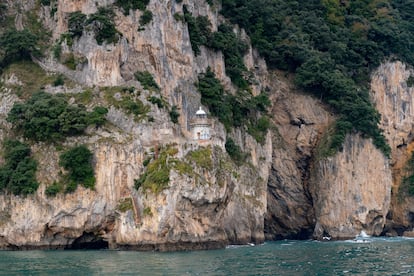The Caballo lighthouse could be on the top of Mount Buciero, the 376-metre colossus that watches over the mouth of Santoña Bay. It would be the highest in Spain: fishermen would see it from 50 kilometres away. But instead, it is almost at the edge of the sea, on a tiny rocky ledge of the same mountain, at the foot of cliffs that are scary to look at, which you reach after going down a staircase of 763 steps, very steep and slippery like ice when wet. Not many people go there, do they? In winter, certainly not. But in summer… In summer, this place, which occupies the podium of the most inaccessible and solitary lighthouses in the world the rest of the year, together with the Icelandic Thridrangar and the Tierra del Fuego San Juan de Salvamento, becomes a super magnet for hikers, sailors, divers, divers and influencers. To such an extent that this summer the Government of Cantabria and the City Council of Santoña, through Cantur, have implemented a pilot test to control access: until September 29 prior reservation is required on-line to access the natural space.
There are no roads nearby: just a footpath, number 1 on Mount Buciero, an old path that French soldiers used to walk up and down all day long, building forts, batteries and powder magazines, when Santoña was the most important Napoleonic stronghold in the north of Spain. You can’t miss it: it’s marked with blue paint and it’s the one that everyone follows from early in the morning. It starts next to the San Martín fort and, after leaving the last houses behind, it goes into a thick Cantabrian oak forest, whose shade is infinitely appreciated in summer. After half an hour of constant and gentle climbing, the forest opens up and you discover the Fraile below, a limestone rock that emerges from the emerald waters, sharp and very white. These views, those of Laredo beach —on the other side of the bay— and those of Mount Candina —to the east— accompany walkers until they reach the detour to the lighthouse in another half hour. A sign warns them of the 763 steps ahead, but you only need to see the flushed faces and bulging varicose veins of those who have just climbed them to understand that they are something serious.
It takes another half hour – one and a half in total – to descend the blessed stairs, stopping frequently to let go of those returning, who are a multitude, and to relax the quadriceps, which soon burn. A steel cable, installed as a handrail, today lessens the vertigo that must have been brutal at the end of the 19th century, when the prisoners of the Santoña Prison Barracks built this astonishing access. Nothing, however, diminishes the impression produced by discovering the lighthouse after going around a pot-bellied rock, almost at the bottom of the stairs. It was lit in 1863 and in 1993 it was abandoned, but it still shines. Such is the dazzle.
Most of them return the way they came (and the next morning most of them can’t even move). Only a few, the wisest and most forward-thinking, remain with Josuco Alonso, Buciero Nature, and they return to Santoña rowing in kayaks. It takes the same amount of time – an hour and a half – and the next day they have the same muscle aches, but spread out between their legs and arms. To get to the water, they still have to go down five flights of narrow, damp and crowded stairs. Young divers go up and down them without stopping, diving into the sea from ramps situated at a good height, bareback or swinging from a rope hanging from the cliff. It is impossible not to remember the video game Lemmings.
Once in the kayaks, you understand why the lighthouse is called the Caballo. That is the shape that, seen from the side, from the sea, the rocky outcrop presents. Right there, two paddles away, is the Asunción shelter, an enormous cave that the Cantabrian Sea has dug into the base of the cliffs and that was once used by ships as a refuge. It is an imposing, cathedral-like cave, with two pointed doorways and a vault full of limestone filigree in which, according to legend, some sailors from Santoña believed they saw the image of the aforementioned virgin in the light of the candles. They asked for help and the gale that had kept them here for five days ceased.

Just after passing under the Peña del Fraile, which was already visible from the heights of the pedestrian path, the kayakers stop to snorkel with the goggles that Josuco gives them from the support boat. Villapececitos: this is the name of this natural aquarium with clear waters and only five meters deep, where octopuses, sardines, sea breams… and anchovies are raised, which, caught in spring, well salted, hand-rubbed and preserved in olive oil, become the world-famous anchovies of Santoña. For dessert, an unexpected sighting: a pod of dolphins. The proof is in a video shared on Instagram by Buciero Natura.
Leaving the Puntal de Laredo to port and the fort of San Carlos to starboard, and a little further on, the fort of San Martín, the kayakers enter the bay of Santoña, from which they left on foot about four hours ago. With the last strokes of the paddle, they approach the Pasaje, the seafront promenade, where the monument to Juan de la Cosa stands, the navigator and cartographer from Santoña who travelled to America seven times, two of them with Christopher Columbus —perhaps three—, and drew his first map. What better place to disembark, even if it is from a small plastic ship.

Subscribe here to the The Traveler’s newsletter and find inspiration for your next trips on our accounts Facebook, X and Instagram.
#Caballo #lighthouse #steps #heaven #hell
